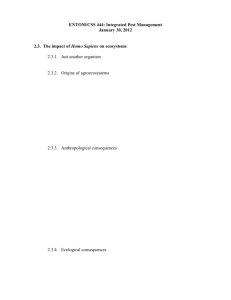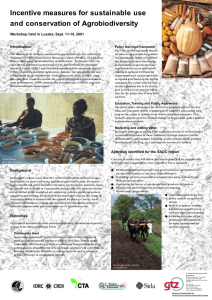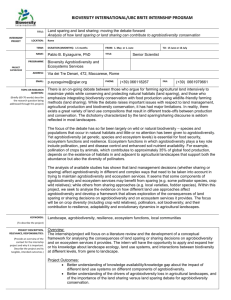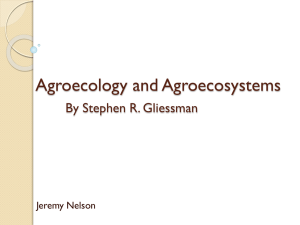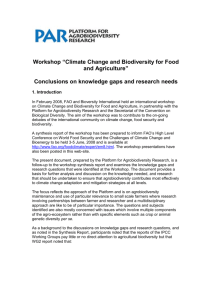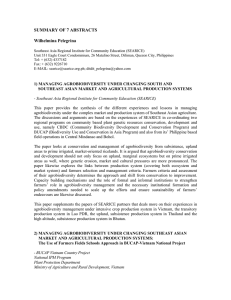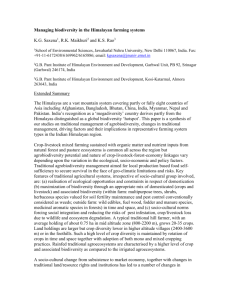Adapting agrobiodiversity to climate change stresses
advertisement
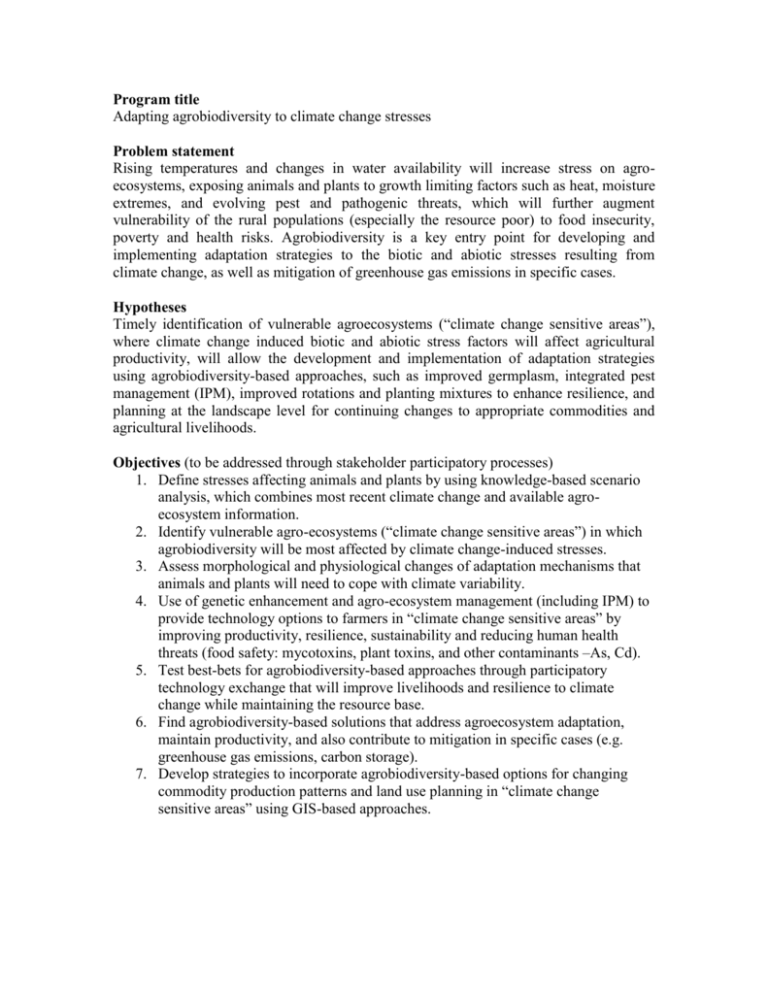
Program title Adapting agrobiodiversity to climate change stresses Problem statement Rising temperatures and changes in water availability will increase stress on agroecosystems, exposing animals and plants to growth limiting factors such as heat, moisture extremes, and evolving pest and pathogenic threats, which will further augment vulnerability of the rural populations (especially the resource poor) to food insecurity, poverty and health risks. Agrobiodiversity is a key entry point for developing and implementing adaptation strategies to the biotic and abiotic stresses resulting from climate change, as well as mitigation of greenhouse gas emissions in specific cases. Hypotheses Timely identification of vulnerable agroecosystems (“climate change sensitive areas”), where climate change induced biotic and abiotic stress factors will affect agricultural productivity, will allow the development and implementation of adaptation strategies using agrobiodiversity-based approaches, such as improved germplasm, integrated pest management (IPM), improved rotations and planting mixtures to enhance resilience, and planning at the landscape level for continuing changes to appropriate commodities and agricultural livelihoods. Objectives (to be addressed through stakeholder participatory processes) 1. Define stresses affecting animals and plants by using knowledge-based scenario analysis, which combines most recent climate change and available agroecosystem information. 2. Identify vulnerable agro-ecosystems (“climate change sensitive areas”) in which agrobiodiversity will be most affected by climate change-induced stresses. 3. Assess morphological and physiological changes of adaptation mechanisms that animals and plants will need to cope with climate variability. 4. Use of genetic enhancement and agro-ecosystem management (including IPM) to provide technology options to farmers in “climate change sensitive areas” by improving productivity, resilience, sustainability and reducing human health threats (food safety: mycotoxins, plant toxins, and other contaminants –As, Cd). 5. Test best-bets for agrobiodiversity-based approaches through participatory technology exchange that will improve livelihoods and resilience to climate change while maintaining the resource base. 6. Find agrobiodiversity-based solutions that address agroecosystem adaptation, maintain productivity, and also contribute to mitigation in specific cases (e.g. greenhouse gas emissions, carbon storage). 7. Develop strategies to incorporate agrobiodiversity-based options for changing commodity production patterns and land use planning in “climate change sensitive areas” using GIS-based approaches. Research questions 1. What are the most important threats that climate anomalies bring to the agrobiodiversity in agro-ecosystems; e.g. temperature and moisture stress, or pest and pathogens for the main species feeding the developing world? 2. How does climate change increase susceptibility of different types of crop plants and livestock toward pests and pathogens? 3. To which degree will this increased susceptibility of current agricultural crops and livestock impact food security and livelihoods in developing countries? 4. Which areas and populations in the developing world will be most affected by the changes, and how does this relate to the agrobiodiversity in these landscapes? 5. What is the genetic potential to mitigate impacts of the climate change induced stresses in different types of crops and livestock? 6. How will the use of traditional ecological knowledge related to agrobiodiversity bring livelihood and cultural benefits for households and communities? 7. Which combinations of genetic improvement and agroecosystem management strategies will influence multiple ecosystem services including agricultural productivity, water quality, energy conservation and human health, e.g. farm worker-pesticide impacts, carbon sequestration, and greenhouse gas emissions? 8. How can land use plans be developed so that agrobiodiversity can be appropriately chosen to provide food security and livelihoods in developing countries during the progressive changes in climate that will occur during the next century? Research methods Compiling databases, gathering of available knowledge, meta-analysis, modeling, spatial analysis, GIS based targeting and hotspot identification, ex-ante impact and trade-off assessments, and participatory priority setting to address objectives 1 and 2. Utilization of genetic resources, physiology, biotech, breeding and animal husbandry research methods to address objectives 3 and 4. Farmer-participatory research methods for implementing objective 5. A combination of above approaches to deal with objective 6. Interdisciplinary approaches to incorporate GIS based analysis of environmental and socioeconomic criteria at the landscape level into land use planning using different agrobiodiversity-based options for the future to address objective 7. Expected outputs over time Populations within identified vulnerable agroecosystems are able to adapt to climate change-induced abiotic and biotic stresses through information gained from the following approaches: 1. Models and decision making system are developed and used to identify and quantify agroecosystem risks by combining information on climate change and plant, animal susceptibility 2. Knowledge of plant, pest, disease interactions that are predicted to increase under the changing climate 3. Technologies are generated that use genetically-improved crops and livestock enabling adaption to and mitigation of the negative impacts of climate change. 4. More reliable, diverse, productive agroecosystems are constructed that ensure food supply sustainably in a changing world. 5. A basket of income-enhancing options is generated through improved agrobiodiversity-based options that change through time. 6. Implementation of practices, such as conservation agriculture, and genetically enhanced technology that provides improved ecosystem services for environmental quality and natural resources (including wild biodiversity), and for human health. 7. Preservation of traditional ecological knowledge and strengthening of household cultural bonds occurs within communities. 8. Land use planning makes recurrent adaptation to changing climate more feasible, and also ensures the conservation of the resource base that supports the production of agricultural commodities and livelihoods. Added value of collaboration between CGIAR and ESSP: Link available knowledge and skills (e.g. modeling) unique to ESSP regarding global and regional climate change combined with CGIAR long term on the ground expertise in agroecosystems of the developing world and large researchfor-development networks (Objectives 1, 2 and 3) Combine ESSP expertise on agrobiodiversity management (agroecosystem services, biodiversity integration, soil biology, conservation agriculture, trade off valuation (farmer income vs. benefits to society), and participatory approaches) and sustainability assessment (e.g. DIVERSITAS) with CGIAR “heartland” research on genebanks, genetic enhancement of crops and animals, integrated pest management, and crop livestock systems (Objective 4, 5, 6, and 7).

